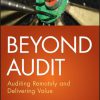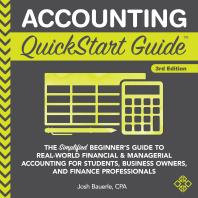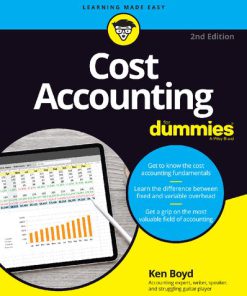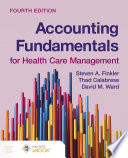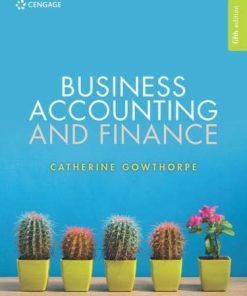Finance and Accounting for Nonfinancial Managers 5th Edition by Steven A Finkler ISBN 9780808046905 080804690X
$50.00 Original price was: $50.00.$25.00Current price is: $25.00.
Finance and Accounting for Nonfinancial Managers 5th Edition by Steven A Finkler – Ebook PDF Instant Download/Delivery: 9780808046905 ,080804690X
Full download Finance and Accounting for Nonfinancial Managers 5th Edition after payment

Product details:
ISBN 10: 080804690X
ISBN 13: 9780808046905
Author: Steven A Finkler
Finance and Accounting for Nonfinancial Managers 5th Edition Table of contents:
Chapter One—An Introduction to Financial Management
What Is Financial Management?
The Goals of Financial Management
Key Terms
Questions for Review
Chapter Two—Excel Basics
Spreadsheets
What Are the Reasons We Use Electronic Spreadsheets
Getting Started with Excel
Alternative Ways to Do Computations
Setting up the Spreadsheet
Automatic Computation Updates
Copying Cells
Summary
Key Terms
Questions for Review
Additional Resources
Chapter Three—Accounting Concepts
Basics
Assets
Liabilities
Owners’ Equity
The Accounting Equation
Key Terms
Questions for Review
Chapter Four—An Introduction to the Key Financial Statements
The Balance Sheet
The Income Statement
The Statement of Cash Flows
Cash Versus Accrual Accounting
Key Terms
Questions for Review
Chapter Five—Where Does the Organization’s Money Come From? Capital Structure
Proprietorships and Partnerships
Not-for-Profit Organizations
For-Profit Corporations
Getting Capital
Key Terms
Questions for Review
Chapter Six—Strategic Planning and Budgeting
Definition and Role of Budgets
Strategic Plan
Long-Range Plan
Annual Budgets
Budget Preparation
Flexible Budgeting
The Cash Budget
Zero-Based Budgeting
Key Terms
Questions for Review
Chapter Seven—Business Plans
Why Develop a Business Plan?
Questions that Drive a Business Plan
The Planning Process
The Elements of a Business Plan
How a Business Plan Is Read
A Successful Business Plan
Key Terms
Questions for Review
Chapter Eight—Cost Accounting
Average vs. Marginal Costs
Cost vs. Expense: The Inventory Process
Period Costs vs. Product Costs
Cost Systems: Process, Job-Order, and Standard Costs
Cost Allocation
Key Terms
Questions for Review
Chapter Nine—Leverage
Financial Leverage
Operating Leverage
Key Terms
Questions for Review
Chapter Ten—Dealing with Uncertainty
The Expected Value Technique
Network Cost Budgeting
Key Terms
Questions for Review
Chapter Eleven—Capital Budgeting
Investment Opportunities
Data Generation
The Payback Method
The Time Value of Money
The Net Present Value (NPV) Method
The Internal Rate of Return Method (IRR)
Project Ranking
Summary
Key Terms
Questions for Review
Chapter Twelve—Earned Value Management
Quantifying Planned Value (PV) and Earned Value (EV)
The Method
Limitation of EVM
Benefits of EVM
Key Terms
Questions for Review
Chapter Thirteen—Depreciation: Having Your Cake and Eating It Too!
Amortization
Asset Valuation for Depreciation
Straight-Line vs. Accelerated Depreciation
Comparison of the Depreciation Methods
Modified Accelerated Cost Recovery System (MACRS)
Depreciation and Deferred Taxes: Accounting Magic
Key Terms
Questions for Review
Chapter Fourteen—Long-Term Financing
Long-Term Notes
Mortgages
Bonds
Leases
Key Terms
Questions for Review
Chapter Fifteen—Working Capital Management and Banking Relationships
Working Capital Management
Short-Term Resources
Short-Term Obligations
Banking Relationships
Key Terms
Questions for Review
Chapter Sixteen—Inventory Costing: The Accountant’s World of Make Believe
The Inventory Equation
Periodic vs. Perpetual Inventory Methods
The Problem of Inflation
Cash-Flow Assumptions
Comparisons of the LIFO and FIFO Cost-Flow Assumptions
Key Terms
Questions for Review
Chapter Seventeen—Variance Analysis: Using Budgets for Control
Understanding Why Variances Occurred
Static Budgets
Flexible Budgeting
Key Terms
Questions for Review
APPENDIX—Computing Variances
Chapter Eighteen—Fraud
What is Fraud?
Business Fraud
Why Does Fraud Happen?
Preventing Fraud by Focusing on Ethics
Preventing Fraud through Legislation
Using Control Systems to Prevent Fraud
Key Terms
Questions for Review
Chapter Nineteen—The Role of the Outside Auditor
Generally Accepted Accounting Principles (GAAP)
International Financial Reporting Standards (IFRS)
The Audit
Key Terms
Questions for Review
Chapter Twenty—Recording and Reporting Financial Information
Double Entry and the Accounting Equation
Debits and Credits
Ledgers
Chart of Accounts
Key Terms
Questions for Review
APPENDIX—Recording and Reporting Financial Information
Chapter Twenty-One—Valuation of Assets, Liabilities and Stockholders’ Equity
Asset Valuation
Valuation of Liabilities
Valuation of Stockholders’ Equity
Key Terms
Questions for Review
Chapter Twenty-Two—A Closer Look at Financial Statements
The Balance Sheet
The Income Statement
The Statement of Cash Flows
Key Terms
Questions for Review
Chapter Twenty-Three—Notes to the Financial Statements
Significant Accounting Policies
Other Notes
Summary
Key Terms
Questions for Review
Chapter Twenty-Four—Ratio Analysis
Benchmarks for Comparison
Common Size Ratios
Liquidity Ratios
Efficiency Ratios
Solvency Ratios
Profitability Ratios
Key Terms
Questions for Review
Chapter Twenty-Five—Accounting for Not-for-Profit Organizations
Not-for-Profit Organizations
Financial Statements
Fund Accounting
Donated Goods and Services
Taxes
Key Terms
Questions for Review
Chapter Twenty-Six—A Primer on Taxes
How Much Do You Need to Know?
Personal vs. Corporate Taxes
The Tax Rate and the Tax Base
Progressive, Proportional, and Regressive Tax Rates
Marginal, Average, and Effective Tax Rates
Calculating Federal Income Tax
Other Concerns for Corporations
Conclusion
Key Terms
Questions for Review
Chapter Twenty-Seven—Summary and Conclusion
Glossary
Annotated List of Web Sites Related to Finance and Accounting
People also search for Finance and Accounting for Nonfinancial Managers 5th Edition:
You may also like…
Commercial & Financial Law
Business & Economics - Accounting
Cost Accounting For Dummies (For Dummies (Business & Personal Finance)) 2nd Edition Kenneth W. Boyd
Business & Economics - Accounting
Accounting Fundamentals for Health Care Management, 4th Edition Steven A. Finkler
Business & Economics - Accounting
Business Accounting and Finance 5th Edition Catherine Gowthorpe
Business & Economics - Accounting
Business & Economics
International Finance 5th Edition by Keith 9781350347090 1350347094
Uncategorized


